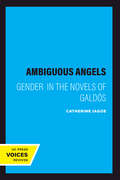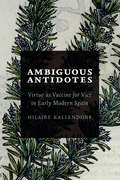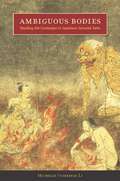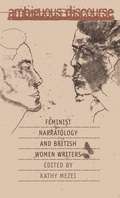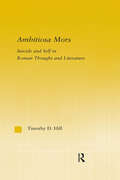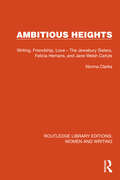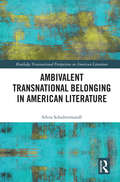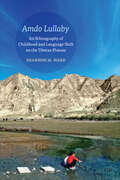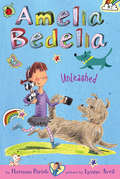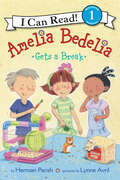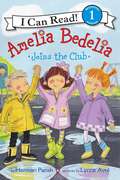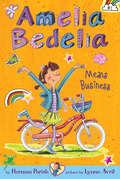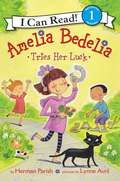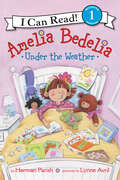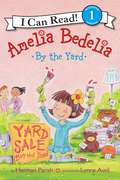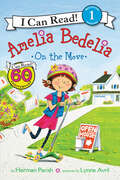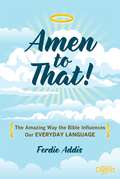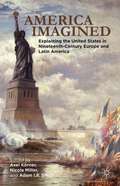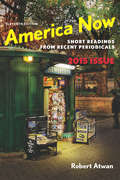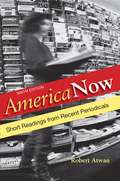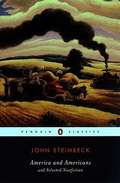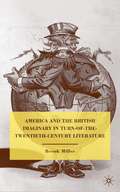- Table View
- List View
Ambiguous Angels: Gender in the Novels of Galdós
by Catherine JagoeThe contradictory nature of the work of Benito Pérez Galdós, Spain's greatest modern novelist, is brought to the fore in Catherine Jagoe's innovative and rigorous study. Revising commonly held views of his feminism, she explores the relation of Galdós's novels to the "woman question" in Spain, arguing that after 1892 the muted feminist discourse of his early work largely disappears. While his later novels have been interpreted as celebrations of the emancipated new woman, Jagoe contends that they actually reinforce the conservative, bourgeois model of frugal, virtuous womanhood—the angel of the house.Using primary sources such as periodicals, medical texts, and conduct literature, Jagoe's examination of the evolution of feminism makes Ambiguous Angels valuable to anyone interested in gender, culture, and narrative in nineteenth-century Europe.
Ambiguous Antidotes: Virtue as Vaccine for Vice in Early Modern Spain
by Hilaire KallendorfChastity and lust, charity and greed, humility and pride, are but some of the virtues and vices that have been in tension since Prudentius’ Psychomachia, written in the fifth century. While there has been widespread agreement within a given culture about what exactly constitutes a virtue or a vice, are these categories so consistent after all? In Ambiguous Antidotes, Hilaire Kallendorf explores the receptions of Virtues in the realm of moral philosophy and the artistic production it influenced during the Spanish Gold Age. Using the Derridian notion of pharmakon, a powerful substance that can serve as poison and cure, Kallendorf’s original and pioneering insight into five key Virtues (justice, fortitude, chastity, charity, and prudence) reveals an intriguing but messy relationship. Rather than being seen as unambiguously good antidotes, the Virtues are instead contested spaces where competing sets of values jostled for primacy and hegemony. Employing an arsenal of tools drawn from literary theory and cultural studies Ambiguous Antidotes confirms that you can in fact have too much of a good thing.
Ambiguous Bodies: Reading the Grotesque in Japanese <I>Setsuwa</I> Tales
by Michelle Osterfeld LiAmbiguous Bodies draws from theories of the grotesque to examine many of the strange and extraordinary creatures and phenomena in the premodern Japanese tales called setsuwa. Grotesque representations in general typically direct our attention to unfinished and unrefined things; they are marked by an earthy sense of the body and an interest in the physical. Because they have many meanings, they can both sustain and undermine authority. This book aims to make sense of grotesque representations in setsuwa—animated detached body parts, unusual sexual encounters, demons and shape-shifting or otherwise wondrous animals—and, in a broader sense, to show what this type of critical focus can reveal about the mentality of Japanese people in the ancient, classical, and early medieval periods. It is the first study to place Japanese tales of this nature, which have received little critical attention in English, within a sophisticated theoretical framework. Li masterfully and rigorously focuses on these fascinating tales in the context of the historical periods in which they were created and compiled.
Ambiguous Discourse
by Kathy MezeiCarefully melding theory with close readings of texts, the contributors to Ambiguous Discourse explore the role of gender in the struggle for narrative control of specific works by British writers Jane Austen, Virginia Woolf, Anita Brookner, Angela Carter, Jeanette Winterson, and Mina Loy. This collection of twelve essays is the first book devoted to feminist narratology--the combination of feminist theory with the study of the structures that underpin all narratives. Until recently, narratology has resisted the advances of feminism in part, as some contributors argue, because theory has replicated past assumptions of male authority and point of view in narrative. Feminist narratology, however, contextualizes the cultural constructions of gender within its study of narrative strategies. Nine of these essays are original, and three have been revised for publication in this volume. The contributors are Melba Cuddy-Keane, Denise Delorey, Rachel Blau DuPlessis, Susan Stanford Friedman, Janet Giltrow, Linda Hutcheon, Susan S. Lanser, Alison Lee, Patricia Matson, Kathy Mezei, Christine Roulston, and Robyn Warhol.
Ambition and Survival
by Christian Wiman"That calling, at once religious, ethical, and aesthetic, is one that only a genuine poet can hear--and very few poets can explain it as compellingly as Mr. Wiman does. That gift is what makes Ambition and Survival, not just one of the best books of poetry criticism in a generation, but a spiritual memoir of the first order." --New York Sun"This weighty first prose collection should inspire wide attention, partly because of Wiman's current job, partly because of his astute insights and partly because he mixes poetry criticism with sometimes shocking memoir ... The collection's greatest strength comes in general ruminations on the writing, reading and judging poetry." --Publishers Weekly"[Wiman is] a terrific personal essayist, as this new collection illustrates, with the command and instincts of the popular memoirist ... This is a brave and bracing book." --Booklist"Blazing high style" is how The New York Times describes the prose of Christian Wiman, the young editor transforming Poetry, the country's oldest literary magazine.Ambition and Survival is a collection of stirring personal essays and critical prose on a wide range of subjects: reading Milton in Guatemala, recalling violent episodes of his youth, and traveling in Africa with his eccentric father, as well as a series of penetrating essays on writers as diverse as Thomas Hardy and Janet Lewis. The book concludes with a portrait of Wiman's diagnosis of a rare form of incurable and lethal cancer, and how mortality reignited his religious passions.When I was twenty years old I set out to be a poet. That sounds like I was a sort of frigate raising anchor, and in a way I guess I was, though susceptible to the lightest of winds. . . . When I read Samuel Johnson's comment that any young man could compensate for his poor education by reading five hours a day for five years, that's exactly what I tried to do, practically setting a timer every afternoon to let me know when the little egg of my brain was boiled. It's a small miracle that I didn't take to wearing a cape.Christian Wiman is the editor of Poetry magazine. His poems and essays appear regularly in The New Yorker, The Atlantic Monthly, Harper's, and The New York Times Book Review.
Ambitiosa Mors: Suicide and the Self in Roman Thought and Literature (Studies in Classics)
by T. D. HillFirst Published in 2004. Routledge is an imprint of Taylor & Francis, an informa company.
Ambitious Heights: Writing, Friendship, Love – The Jewsbury Sisters, Felicia Hemans, and Jane Welsh Carlyle (Routledge Library Editions: Women and Writing)
by Norma ClarkeHow did the Victorian woman cope with the image of herself as a writer? What were the constraints on female friendships in a world centred on the pre-eminence of the husband? How significant for an ambitious woman were her politics about men? At the heart of this book, originally published in 1990, is a friendship between two women: Jane Carlyle and the novelist Geraldine Jewsbury. But it was a difficult friendship, and in its difficulty lies much that is illuminating: about nineteenth-century domestic ideology; about writing for a market, and female fame; and about the complex ambivalences between women. Examining aspects of their lives, writing, and relationships, alongside those of two other writers – Felicia Hemans and Geraldine’s sister, Maria Jane – Norma Clarke provides a subtle and illuminating discussion of the possibilities that were open to women in the Victorian age.
Ambivalent Transnational Belonging in American Literature (Routledge Transnational Perspectives on American Literature)
by Silvia SchultermandlAmbivalent Transnational Belonging in American Literature discusses the extent to which transnational concepts of identity and community are cast within nationalist frameworks. It analyzes how the different narrative perspectives in texts by Olaudah Equiano, Catharina Maria Sedgwick, Henry James, Jamaica Kincaid, and Mohsin Hamid shape protagonists’ complex transnational subjectivities, which exist between or outside national frameworks but are nevertheless interpellated through the nation-state and through particular myths about liberal, sentimental, or cosmopolitan subjects. The notion of ambivalent transnational belonging yields insights into the affective appeal of the transnational as a category of analysis, as an aesthetic experience, and as an idea of belonging. This means bringing the transnational into conversation with the aesthetic and the affective so we may fully address the new conceptual challenges faced by literary studies due to the transnational turn in American studies.
Amdo Lullaby: An Ethnography of Childhood and Language Shift on the Tibetan Plateau (Anthropological Horizons)
by Shannon WardIn Amdo, a region of eastern Tibet incorporated into mainland China, young children are being raised in a time of social change. In the first decades of the twenty-first century, Chinese state development policies are catalysing rural to urban migration, consolidating schooling in urban centres, and leading Tibetan farmers and nomads to give up their traditional livelihoods. As a result, children face increasing pressure to adopt the state’s official language of Mandarin. Amdo Lullaby charts the contrasting language socialization trajectories of rural and urban children from one extended family, who are native speakers of a Tibetan language known locally as “Farmer Talk.” By integrating a fine-grained analysis of everyday conversations and oral history interviews, linguistic anthropologist Shannon M. Ward examines the forms of migration and resulting language contact that contribute to Farmer Talk’s unique grammatical structures, and that shape Amdo Tibetan children’s language choices. This analysis reveals that young children are not passively abandoning their mother tongue for standard Mandarin, but instead are reformatting traditional Amdo Tibetan cultural associations among language, place, and kinship as they build their peer relationships in everyday play.
Amelia Bedelia Chapter Book #2: Amelia Bedelia Unleashed (Amelia Bedelia #No. 2)
by Herman ParishIn the second book in the new chapter book series, young Amelia Bedelia spends time with dogs and discovers why they are man's (and girl's) best friends. With Amelia Bedelia anything can happen, and it usually does. Full color.
Amelia Bedelia Gets a Break (I Can Read Level 1)
by Herman ParishLearn to read with young Amelia Bedelia!The Amelia Bedelia books are great for growing the vocabularies of newly independent readers. In Amelia Bedelia Gets a Break, Amelia Bedelia is put in charge of caring for her class hamster over a school vacation. But Amelia Bedelia gets more than she bargained for when the hamster goes missing!Amelia Bedelia is left in charge of her class pet—a hamster named Harry—over school break, and she’s excited to learn all about caring for an animal. But when Harry goes missing, Amelia Bedelia is upset. Her friends Dawn and Clay help her search the house and make “lost pet” signs, but it seems hopeless, until Amelia Bedelia puts herself in Harry’s shoes and finds him hiding in her favorite spot in the house.A Level 1 I Can Read book featuring the childhood of America’s favorite housekeeper, Amelia Bedelia. More than thirty-five million Amelia Bedelia books sold since 1963!
Amelia Bedelia Joins the Club (I Can Read Level 1)
by Herman ParishLearn to read with young Amelia Bedelia! Amelia Bedelia has been loved by readers for more than fifty years, and it turns out that her childhood is full of silly mix-ups, too!Amelia Bedelia loves her school. Her whole class gets along—except when it rains. Then they split into two groups—the Puddle Jumpers and the Puddle Stompers. Both clubs ask Amelia Bedelia to join, but she doesn't want to choose between her friends. Oh, no! Luckily Amelia Bedelia finds a solution that makes a big splash with everyone. The childhood adventures of America's favorite housekeeper will keep newly independent readers laughing, reading, and expanding their vocabularies!Amelia Bedelia Joins the Club is a Level 1 I Can Read book, which means it's perfect for children learning to sound out words and sentences.
Amelia Bedelia Means Business (I Can Read! #36)
by Herman ParishWhen Suzanne, the new girl in Amelia Bedelia's class, arrives at school riding the most beautiful bicycle in the whole world, Amelia Bedelia decides she wants a new bike, too. But Amelia Bedelia's mom says that a bike like Suzanne's is so expensive it will cost an arm and a leg! What? Amelia Bedelia doesn't want to give away one of her arms and one of her legs. She'll need both arms to steer her new bike, and both legs to pedal it. Amelia Bedelia decides to get a job, so that she can earn the bike money instead.
Amelia Bedelia Tries Her Luck (I Can Read Level 1)
by Herman ParishAmelia Bedelia Tries Her Luck is a funny I Can Read adventure, starring Amelia Bedelia as a young girl, that is just right for beginning readers. Amelia Bedelia, America's favorite housekeeper, has been making readers laugh for fifty years!America's favorite housekeeper investigates all kinds of good luck and bad luck in this beginning reader starring Amelia Bedelia as a young girl. Why is it unlucky for a black cat to cross your path? Why does a horseshoe bring good luck? If you step on a crack, will you really break your mother's back? Amelia Bedelia, who always takes things literally, tries to understand common superstitions in this funny book about friendship
Amelia Bedelia Under the Weather (I Can Read Level 1)
by Herman ParishLearn to read with young Amelia Bedelia! The Amelia Bedelia books are great for growing the vocabularies of newly independent readers.In Amelia Bedelia Under the Weather, Amelia Bedelia wakes up feeling, well, under the weather! But with a little rest, some delicious chicken soup, and a lot of love, Amelia Bedelia is soon as right as rain! More than thirty-five million Amelia Bedelia books sold since 1963. Amelia Bedelia is feeling under the weather. While it rains cats and dogs outside, Amelia Bedelia is stuck in bed with a fever. She passes the time by learning all about weather around the world. And with a lot of rest and a big bowl of Mrs. Adams’s chicken soup, Amelia Bedelia will be back on her feet soon.A Level 1 I Can Read book featuring the childhood of America’s favorite housekeeper, Amelia Bedelia! Whether shared at home or in a classroom, the short sentences, familiar words, and simple concepts of Level One books support success for children eager to start reading on their own.
Amelia Bedelia by the Yard (I Can Read Level 1)
by Herman ParishLearn to read with young Amelia Bedelia! Amelia Bedelia has been loved by readers for more than fifty years, and it turns out that her childhood is full of silly mix-ups, too!Amelia Bedelia’s parents are holding a yard sale—but Amelia Bedelia loves playing in her yard, and she doesn’t want to sell it! Luckily, her mother promises they will only sell things in the yard. When one neighbor wishes she could buy the flowers, Amelia Bedelia fetches a shovel to dig some up. After all, a yard will always grow back! The Amelia Bedelia books are great for growing the vocabularies of newly independent readers. Amelia Bedelia by the Yard is a Level 1 I Can Read book, perfect for children learning to sound out words and sentences. More than 35 million Amelia Bedelia books sold since 1963!
Amelia Bedelia on the Move (I Can Read Level 1)
by Herman ParishLearn to read with young Amelia Bedelia! Amelia Bedelia has been loved by readers for more than fifty years, and it turns out that her childhood is full of silly mix-ups, too!The star of the bestselling picture book series now has her own Level 1 I Can Read books that will keep newly independent readers laughing, reading, and expanding their vocabularies. In this latest adventure, when Amelia Bedelia’s parents decide to look for a new house, Amelia Bedelia discovers what really makes a home. Amelia Bedelia loves the house she lives in, and she really loves her neighborhood. But when her parents suggest a move, she turns it into an adventure. Together they visit open houses, explore new neighborhoods, and discover that home is where the heart is. Amelia Bedelia learns all about different types of houses in this Level 1 I Can Read full of family and adventure.
Amen to That!
by Ferdie AddisMany of us have never read or studied the Bible, yet people have been quoting from its pages for centuries, not knowing the origin or significance of these timeless expressions. Let there be light! Amen to That will delightfully shed clarity on how a collection of ancient stories, written in three languages over the course of a thousand years, has had such an impact on the way we speak today. Through intriguing stories and riveting tales of epic battles and acts of betrayal to miracles and beyond, you'll quickly discover the meanings behind such familiar phrases as: A drop in the bucket All things must pass As old as the hills Bite the dust Eat, drink, and be merry The powers that be Woe is me Amen to That is a wonderful look at the gripping storytelling and cultural wealth to be found in the world's best-selling book, as well as a fascinating insight into our language.
America Imagined
by Axel K�rner Nicola Miller Adam I. P. SmithThis is an exploration of how Latin America developed an alternative modernity during the early twentieth century, one that challenges the key assumptions of the Western dominant model.
America Now
by Robert AtwanAmerica Now makes it easy for you to bring brief, thought-provoking essays into your classroom, with reliable pedagogy and an expert reader's knowledge of what works for students. As series editor for The Best American Essays, Robert Atwan constantly scours a wide range of periodicals, bringing to America Now an unrivaled focus on today's best writing. Instructors tell us that their students want to respond to the essays in the book, and they praise the high-quality reading and writing instruction, critical thinking and reading questions, and model student essays that help them do so. Every current, professional reading in America Now is new to this edition, making it truly a book for today's composition course.
America Now
by Robert AtwanAmerica Now makes it easy for you to get brief, accessible, and thought-provoking essays into your classroom, with trustworthy, reliable pedagogy and an expert reader's knowledge of what works in the classroom. As series editor for Best American Essays, Robert Atwan constantly scours a wide range of periodicals, bringing to America Now an unrivaled focus on the best writing on today's issues. Instructors tell us that their students want to respond to the essays in the book, and they praise the high- quality reading and writing instruction, critical thinking and reading questions, and model student essays that help them do so. Every reading in America Now is new to this edition, making it truly a book for today's composition course.
America Now: Short Readings From Recent Periodicals, 11th Edition
by Robert AtwanAmerica Now makes it easy for you to get brief, accessible, and thought-provoking essays into your classroom, with trustworthy, reliable pedagogy and an expert reader's knowledge of what works in the classroom. As series editor for Best American Essays, Robert Atwan constantly scours a wide range of periodicals, bringing to America Now an unrivaled focus on the best writing of today. Instructors tell us that their students want to respond to the essays in the book, and they praise the high-quality reading and writing instruction, critical thinking and reading questions, and model student essays that help them do so. Every reading in America Now is new to this edition, making it truly a book for today's composition course. And now with the new edition, you can meet students where they are: online. To package LaunchPad Solo for Readers and Writers free with America Now, use 978-1-319-01552-7.
America Now: Short Readings from Recent Periodicals
by Robert AtwanWith more than 50 very brief readings -- all new to this edition -- from over 40 very recent periodicals and student newspapers on 12 topics of very current interest,America Nowreflects what students are talking and writing about right now. As series editor ofThe Best American Essays, Robert Atwan constantly scours a wide range of periodicals, bringing toAmerica Nowan unrivaled awareness of the best writing on today's hottest issues -- and the editorial support students need to approach it and to create solid academic writing of their own. To make these issues especially relevant for students, Atwan also explores hundreds of campus newspapers to find the best student writing on current topics. These models by their peers from across the country show students that they, too, can share ideas through their own discussion and writing.
America and Americans and Selected Nonfiction
by John Steinbeck Susan Shillinglaw Jackson J. BensonMore than four decades after his death, John Steinbeck remains one of the nation's most beloved authors. Yet few know of his career as a journalist who covered world events from the Great Depression to Vietnam. Now, this distinctive collection offers a portrait of the artist as citizen, deeply engaged in the world around him. In addition to the complete text of Steinbeck's last published book, America and Americans, this volume brings together for the first time more than fifty of Steinbeck's finest essays and journalistic pieces on Salinas, Sag Harbor, Arthur Miller, Woody Guthrie, the Vietnam War and more. This edition is edited by Steinbeck scholar Susan Shillinglaw and Steinbeck biographer Jackson J. Benson. .
America and the British Imaginary in Turn-of-the-Twentieth-Century Literature
by Brook MillerIn an innovative reading of fin-de-siecle cultural texts, Miller argues that British representations of America, Americans, and Anglo-American relations at the turn of the twentieth century provided an important forum for cultural distinction.
